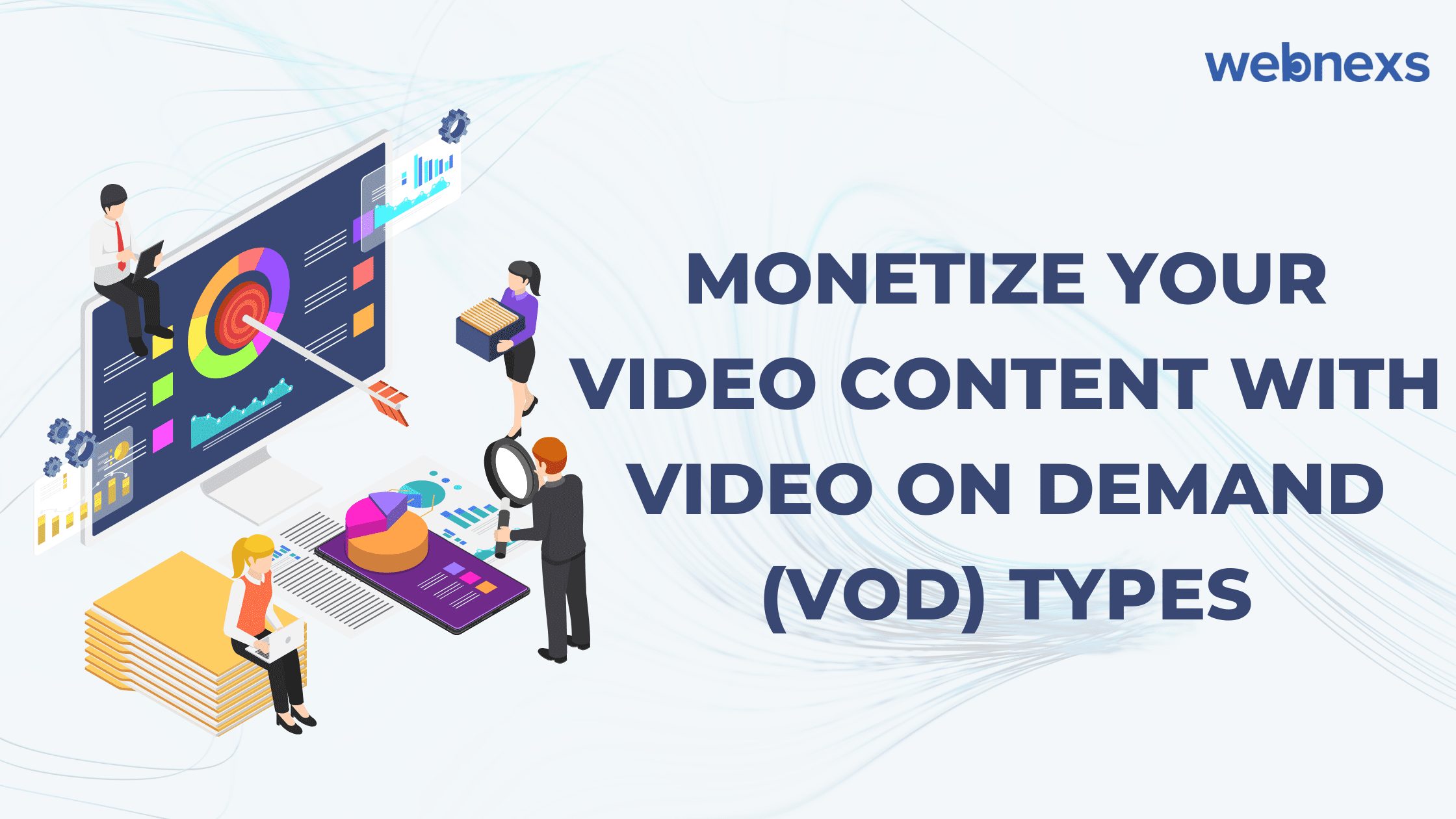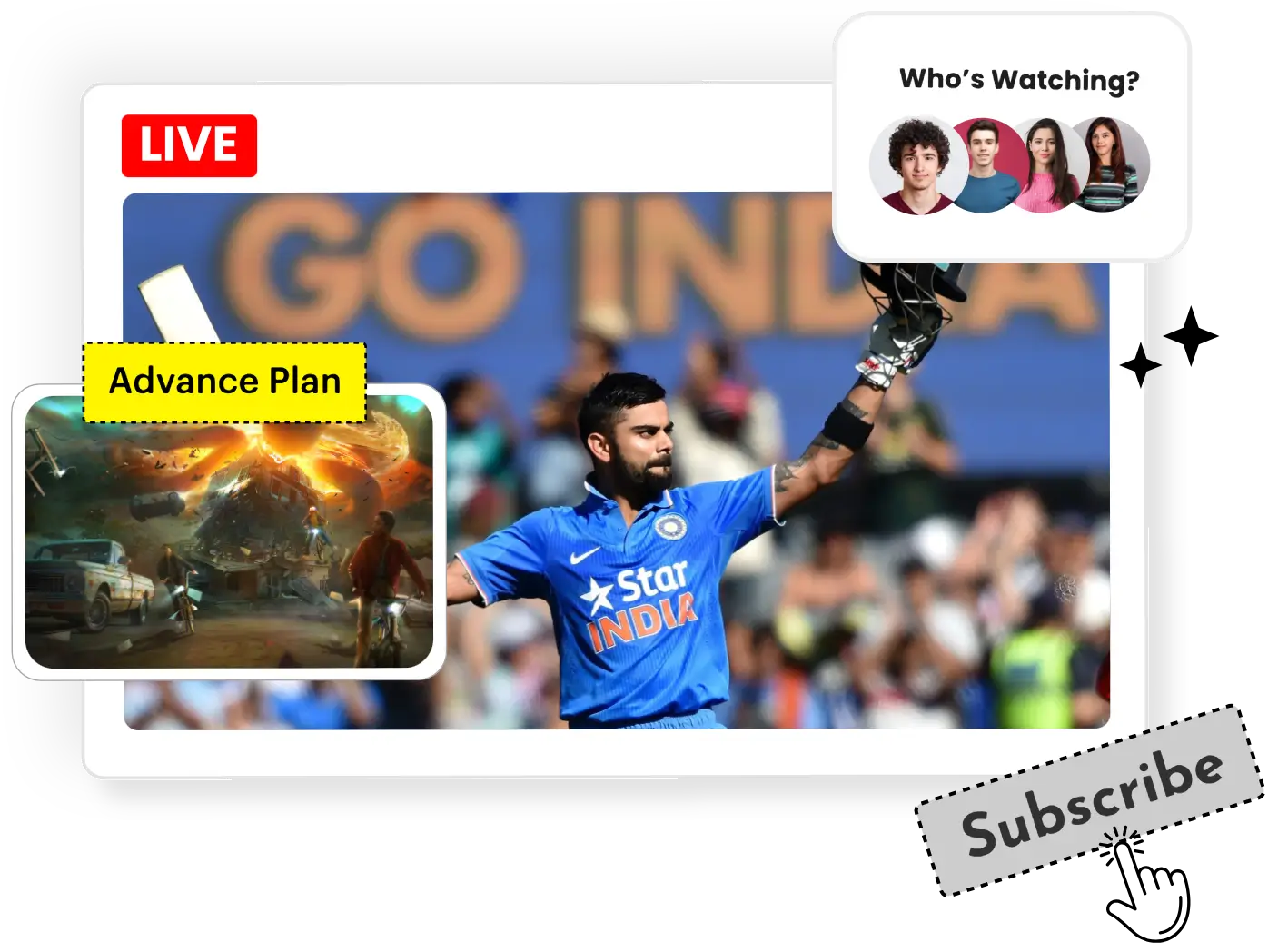Video On Demand (VOD) is a new and exciting way to watch TV shows and movies. The catch is that you don’t have to wait for your remote controls to arrive at your house; instead, you can stream it from your favorite device (mobile phone, tablet, laptop) that is synchronal with your Netflix account.
The good news is that the VOD Monetization industry is rapidly expanding and already provides lucrative revenue streams for content creators and businesses.
This article provides some basic definitions of VOD and the various types of VOD.
When it comes to streaming content, after seeing abbreviations like VOD, OTT, SVOD, AVOD, and others, you are perhaps asking yourself, what is VOD? What does it stand for? What is the difference between SVOD vs. AVOD?
Have no fear. We’ll explain.
After this post, you’ll be proficient on Video-on-demand platforms for VOD monetization. That way, they monetize them. Which is the right monetization strategy for you?
Video on demand is the best way to build your community and monetize your hard work. “VOD” means “Video on Demand (VOD).” Also, work well.
- Fitness Industry
- Religious Organizations
- Entertainment
- Education
- Virtual Events
Many popular fitness classes went digital and succeeded in their streaming channels worldwide.
Others have pivoted to social media as they stay home to keep themselves and their communities safe. Yoga studios have turned to digital sessions, dancers are changing their rooms to studios, and education has started to videos and content for kids’ entertainment and education.
Whether you have some videos filmed and ready to move, a favored channel and a posse of loyal followers, or eventually get your first ring light and are prepared to make your first video.
We’ll move you through various ways to your VOD monetization channel and help you select the pricing strategy that suits best you.
VOD Monetization has never been simple. Click here to monetize your content today!
Video On Demand (VOD): What You Need to Know about VOD Monetization
VOD stands for video on demand, a method to consume the video that drops under the larger game of the distribution method of OTT video, the future generation of digital streaming is Video-on-demand or VOD streaming. OTT means “over-the-top” streaming content is delivered directly by cable access.
Selecting a VOD platform
When you are searching out a Video-on-demand platform for VOD monetization, there are a few essential things to study:
Does this platform host your content and permit monetization?
Can it offer streaming across all device types?
Does it offer high-quality streaming? Low-quality video can make or break a subscriber’s experience and may contribute to churn.
Once you have picked a VOD platform, it’s time to think about how you can start earning revenue from your content.
Related: SVOD vs TVOD vs AVOD : Which is the Best VOD Monetization Model in 2021
Supercharge Your Earnings: Monetize Your Video with SVOD, TVOD, and AVOD
People need niche video content and are eager to pay for quality subscriptions. There are a few various choices when it comes to how you can charge people for your content, then how you can price once you decide
The vital tip for VOD monetization strategies are:
- Subscription video on demand (SVOD)
- Advertising-based video on demand (AVOD)
- Transactional video on demand (TVOD).
Every model has various values. It decides on your business, audience, and goals. Let’s take a glaze at each VOD monetization streaming model and how they will assist your business growth
1. Subscription VOD (SVOD)
StreamingMedia predicts SVOD subscribers will boom from 199 million to 307 million by 2025.
What’s the meaning of SVOD?
SVOD is a video or VOD monetization strategy based on reappearing revenue, generally monthly or annual subscriptions.
SVOD – subscription video on demand (VOD).
The important things to keep in mind when monetizing your video content through SVOD are:
Make your content specific to your particular audience. SVOD content is successful when started for a niche set. Subscribers are more likely to check in if it’s content that isn’t available anywhere else. These subscribers will also hang around and offer more lifetime value.
Deliver content regularly and notify your subscribers when new content. If you deliver your content occasionally, subscribers are more likely to unsubscribe and stop paying for your channel.
How do “SVOD” platforms create more income in streaming video content?
Benefits of SVOD
- Provides flexible subscription options
- Builds an ongoing revenue stream
- Win your audience and builds loyal subscribers
- It offers you the power to publish exclusive content
2. Transactional VOD (TVOD)
Following abbreviation coming in hot! TVOD is an acronym for transactional video on demand and introduces the process of purchasing or renting a piece of content. In the case of live events,
TVOD complete form – transactional video on demand (VOD)can also serve as Pay-Per-View (PPV).
What’s the meaning of TVOD?
TVOD is when your audience can select to pay for separate videos (for buy or rent) rather than subscribing to surge your whole video library.
TVOD is generally a complement to an SVOD strategy. Examples of TVOD models include Amazon Prime Video and Google Play.
The important things to keep in mind when monetizing your video content through TVOD are:
When doing VOD monetization using TVOD, you can endorse a particular delivery for purchase or rent, like a new movie. TVOD is intentional for huge audiences who may not be consistent since there’s no fee to join. Anyone can buy your content. Promote exclusive or brand fresh content using TVOD and offer multiple pricing options.
How Pay-per-view concepts are applied in TVOD platforms to publish your media contents?
Benefits of TVOD
- Permits you to release exclusive, timely content
- Lets you the freedom to offer single videos, series, or feature films
- Provides options of videos to be rented or bought, broadening your audience
3. Advertising-based VOD (AVOD)
The final abbreviation comes with: AVOD – advertising-based video on demand (VOD). A well-known example of AVOD is YouTube. AVOD is helpful for those with a vast audience or followers since separate ad views pay small amounts of money and need large volumes for actual revenue. Various little OTT creators learn they can earn a more stable income through an SVOD or a mix of SVOD and TVOD models.
What’s the meaning of AVOD?
AVOD means you stream your video content for free but need viewers to view ads. Ad revenue pays you to build your content and present it without a subscription or fee.
Benefits of AVOD
- Lets your audience the opportunity to view your content for free, building a low barrier to entry
- Does not need a cable or satellite subscription
- Obtainable to a broader audience
- Offers a scalable revenue solution for huge or increasing audiences
Now, let’s consider which VOD monetization model suits for you.
Selecting a monetization strategy for your video content: AVOD vs. SVOD vs.TVOD
Empower Your Content Strategy: Evaluate and Build Your Audience
Where, What method does your target audience consume video content? How many followers do you have?
Niche audiences are loyal and may be interested in a long-term relationship with you, such as SVOD. They are more likely to need to return to videos and watch them regularly on their own time.
Broad entertainment audiences are less likely to stick with you month after month. These users prefer to pick and choose which videos they want to watch.
Visit Here: How to start a VOD streaming platform and its advantages?
Unleash Your Potential: The Current State of Your Video Content and Strategy
If you earlier have a vast content database of videos and need to monetize, you can take your choice of strategy. Still, if you are creating out and haven’t yet obtained an audience or content, it may form sense to create with AVOD and try out your content before placing it behind a paywall.
What industry do you work along?
Most audiences are more likely to advantage of a stretchable solution than others. Parents keep depending on subscriptions since their kids look at the content they like and don’t want to change things up. Kids are also the best audience for the freedom of a subscription, rather than the constraints of a 48-hour rental or having to sit via ads. Have you ever tried to obtain a kid to do anything on a schedule? Trust me. It’s not easy. Depending on your audience, Several VOD monetization strategies work for many groups.
There are a few choices for you to select from when selling your video content online. Let’s analyze the different models (SVOD vs. AVOD vs. TVOD) and the best use for VOD monetization.
- Subscription video on demand: provide a subscription to your video channel and deliver fresh content regularly.
- Transactional video on demand: Provide separate videos for buying like fresh delivery or exclusive content. TVOD works best when you promote introduces of your content and build up to releasing new videos.
- Advertising-based video on demand: In this model, you can give free content and get paid by advertisers for conveying ads to your audience. It works best when you have a vast, engaged audience and can provide suitable ads.
SVOD vs. TVOD vs. AVOD: Which is the Best VOD Monetization Model in 2021
VOD video is both the present and future of professional broadcasting. We suggest exploring this industry as it continues to increase so that you’ll note yourself at the top as it blooms to its potential.
When it comes to video or VOD monetization, you have several routes to take. Now you are an acronym pro. You are ready to gear video on demand (VOD) and monetize your popular channel.



15 Responses
Useful information on VOD streaming monetization model and benefits of SVOD, AVOD, TVOD
Clear understanding on SVOD, AVOD, TVOD model. These model of video monetization will choose our business, audience, and goals based on our requirements
Thanks for sharing the VOD Monetization model on Svod,Tvod,Avod. which help to improve my video on demand business
The above mentioned video content monetization models helps to improve our VOD business and start earning profits from our content.
When it comes to selling our video content online. we have to check with these models (SVOD ,AVOD,TVOD) and Choose the right one and use for monetization.
Blog is outstanding! Thank you for the efforts you have put in writing this blog into a how to monetization video content using avod vs svod vs tvod.
Hey!!!
Thanks for your great post. Its good to see an article that stands out on Video Monetization that helps anyone with pleasing video contents
This blog is useful and help many people to picked a VOD platform, it’s time to think about how you can start earning revenue from your content.
The comparison of Video Content using SVOD, TVOD, and AVOD are simple and easy to understand
Svod, avod, tvod are very important to video streaming, this blog detailed explained the 3 models, if implements this strategies to platform, it will definitely reach the auidence
Amazing blog about video streaming, clarification of svod, avod, tvod is truly useful.
This is one of the Trending technologies, i searched a lot of sites for this video streaming information. Finally, I found this site. Keep doing like this .
hi
through this blog i get more information about video streaming monetization, thanks for this post.
Clear explanation of svod, tvod, avod. This model decides our business, audience, and goals. I get clear knowledge of these models.
Nice blog about the video streaming monetize, very useful to my business, thank you